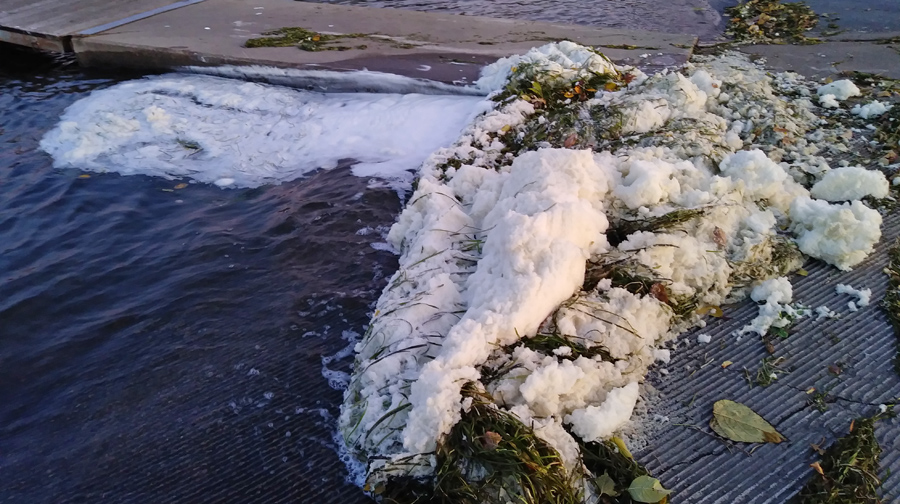PFAS in Foam Far Worse Than Water in Wisconsin’s Rivers, Lakes
Study finds PFAS levels in foam were 50 to 7,000 times higher than in the water.

Foam present in Starkweather Creek in October 2019 shows elevated levels of PFOS and PFOA (PFAS chemicals). Photo from courtesy of the DNR.
Researchers at the University of Wisconsin-Madison have found that naturally occurring foams on state waterways have PFAS levels as much as thousands of times higher than waters that lie below.
The findings are part of a new study published in the journal Environmental Science & Technology. Researchers studied 36 different types of PFAS in samples collected from foams and the very top layer of the water column across 43 rivers and lakes in Wisconsin.
Christina Remucal is a co-author of the study and a professor of civil and environmental engineering at UW-Madison. She said the PFAS concentrations in foam were “jaw-dropping.” Samples of foam collected from Lake Monona showed PFAS levels up to roughly 328,000 parts per trillion.
“So just for comparison, the new (federal) drinking water regulations are 4 (parts per trillion) in comparison with over 300,000,” Remucal said. “So these are really high numbers.”
PFAS are a class of thousands of synthetic chemicals used in cookware, food wrappers, stain-resistant clothing and firefighting foam. They don’t break down easily in the environment. High exposure to the chemicals has been linked to kidney and testicular cancers, fertility issues and other serious health problems.
Among samples collected, Remucal said PFAS concentrations in foam ranged from 50 to 7,000 times higher than levels in the water. Rivers and lakes contained much lower levels of the chemicals, ranging from 6 parts per trillion in the Menominee River to 139 parts per trillion in Green Bay.
Lake Monona had the highest PFAS levels in foam statewide. Lake Monona is known to be impacted by the use of firefighting foam that contains PFAS at the Dane County Regional Airport. Sampling by the Wisconsin Department of Natural Resources has consistently shown elevated levels of the chemicals beyond the state’s PFAS standard of 8 parts per trillion for surface waters.
Remucal said higher PFAS levels in foam were also found in Dane County’s Lake Waubesa, the Green Bay shore and the Peshtigo River.
Researchers say the findings reinforce warnings issued by Wisconsin and Michigan about avoiding contact with any foam observed on waterways.
Sarah Balgooyen co-authored the study during her time as a post-doctoral researcher at UW-Madison. Now a research scientist with the EPA, Balgooyen said the main way people are exposed to PFAS is through ingestion. She said that may occur while swimming in water with foam containing the chemicals. “If you accidentally swallow that foam, that would not be good, especially for kids or dogs that are playing in the water,” Balgooyen said. “If you see foam out there, you want to keep them away from that because that means that foam probably has higher levels of PFAS.”
Remucal added they found higher concentrations of PFAS in foam in places where they expected to find it, such as downstream from airports that used foam containing the chemicals. However, they also found PFAS levels in foam as high as 2,000 parts per trillion within waterways that had lower concentrations of the chemicals and no known sources of PFAS nearby.
“So even if the lake didn’t have a lot of PFAS in it, you could still find these elevated levels in the foam,” Remucal said.
Remucal noted that the chemical PFOS is more likely to accumulate in foam than other PFAS compounds. The presence of PFOS has driven fish consumption advisories in Madison area waterways, the Bay of Green Bay, Lake Wausau and Lake Superior.
Researchers examined the very top layer of the water column that touches the air because PFAS are surfactants, meaning they are drawn to where the air and water meet. They also collected samples from deeper in the water and compared the findings.
The study found PFAS levels were only slightly higher in the very top layer as opposed to the underlying water. Remucal said the findings are important for determining how PFAS move in groundwater, such as with any release of the chemicals.
The study was funded by a grant from the Wisconsin Sea Grant College Program.
Study finds foam on Wisconsin rivers and lakes has higher PFAS levels than waters below was originally published by Wisconsin Public Radio.
If you think stories like this are important, become a member of Urban Milwaukee and help support real, independent journalism. Plus you get some cool added benefits.
More about the PFAS Problem
- Bipartisan Push to Tell Counties Faster When Water Tests Fail - Henry Redman - Dec 19th, 2025
- MKE County: County Seeks to Sue PFAS Producers, Oil Companies - Graham Kilmer - Dec 10th, 2025
- Wisconsin Reviewing EPA-Approved Pesticides For PFAS - Danielle Kaeding - Dec 9th, 2025
- State Nears Settlement with Johnson Controls/Tyco Over PFAS Spills - Danielle Kaeding - Dec 4th, 2025
- Senate Bill Promotes Soybean-Based Firefighting Foam to Replace PFAS - Danielle Kaeding - Dec 2nd, 2025
- Test Results Show High PFAS Levels in Wisconsin’s Landfill Runoff - Danielle Kaeding - Dec 2nd, 2025
- Wisconsin Communities Get $282 Million for Drinking Water Projects - Danielle Kaeding - Nov 19th, 2025
- Gov. Evers, DNR Announce $282 Million to Improve Drinking Water Quality for Wisconsinites in 74 Municipalities - Gov. Tony Evers - Nov 18th, 2025
- Cleanup of PFAS Could Cost Wisconsin Billions - Danielle Kaeding - Nov 13th, 2025
- Cleanup PFAS Without Penalizing Innocent Landowners - Wisconsin Manufacturers & Commerce - Nov 4th, 2025
Read more about PFAS Problem here





















